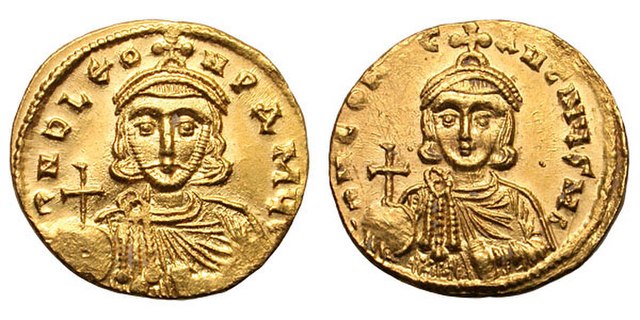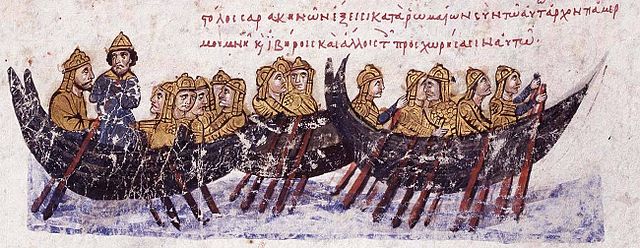The Byzantine navy was the naval force of the Byzantine Empire. Like the state it served, it was a direct continuation from its Roman predecessor, but played a far greater role in the defence and survival of the state than its earlier iteration. While the fleets of the Roman Empire faced few great naval threats, operating as a policing force vastly inferior in power and prestige to the army, command of the sea became vital to the very existence of the Byzantine state, which several historians have called a "maritime empire".
By the late 5th century, the Western Mediterranean had fallen into the hands of barbarian kingdoms. The conquests of Justinian I restored Roman control over the entire sea, which would last until the Muslim conquests in the latter half of the 7th century.
Emperor Leo III the Isaurian and his son and successor, Constantine V. Together, they spearheaded a revival of Byzantine fortunes against the Arabs, but also caused great internal strife because of their iconoclastic policies.
The Saracen pirate fleet sails towards Crete. From the Madrid Skylitzes manuscript.
Gold solidus of Emperor Basil I the Macedonian. His patronage of the fleet resulted in several successes and was long remembered by the sailors, forming strong ties of loyalty to the Macedonian dynasty that was felt up until the reign of his grandson, Constantine VII.
The naval forces of the ancient Roman state were instrumental in the Roman conquest of the Mediterranean Basin, but it never enjoyed the prestige of the Roman legions. Throughout their history, the Romans remained a primarily land-based people and relied partially on their more nautically inclined subjects, such as the Greeks and the Egyptians, to build their ships. Because of that, the navy was never completely embraced by the Roman state, and deemed somewhat "un-Roman".
Three-banked ("trireme") Roman quinquereme with the Corvus boarding bridge. The use of the Corvus negated the superior Carthaginian naval expertise, and allowed the Romans to establish their naval superiority in the western Mediterranean.
Roman as coin of the second half of the 3rd century BC, featuring the prow of a galley, most likely a quinquereme. Several similar issues are known, illustrating the importance of naval power during that period of Rome's history.
Pompey the Great. His swift and decisive campaign against the pirates re-established Rome's control over the Mediterranean sea lanes.
Silver denarius struck by Sextus Pompeius in 44–43 BC, featuring a bust of Pompey the Great and a Roman warship.








